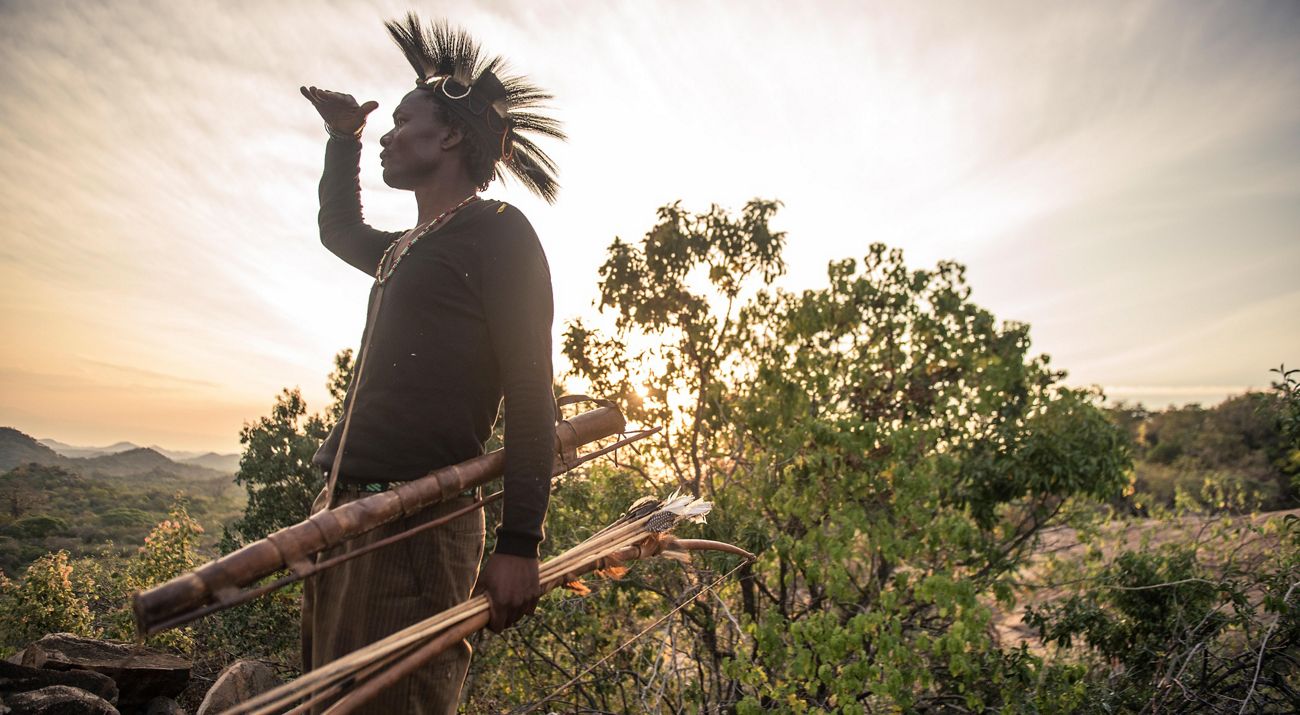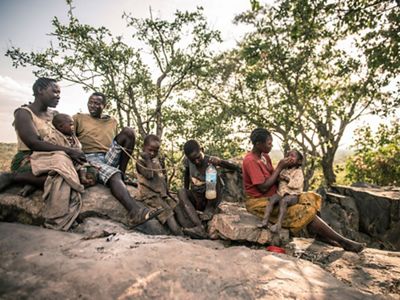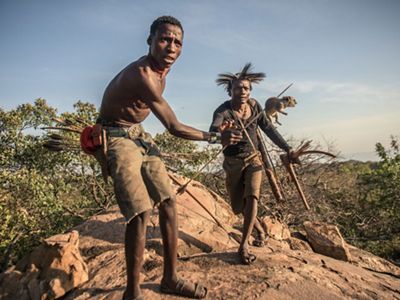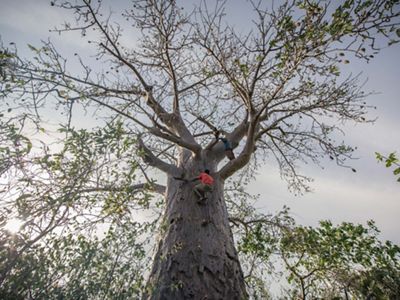
Survival in the Great Rift
In the face of growing development pressures, native communities in northern Tanzania secure the right to keep their homelands wild.
December/January 2015
In the scrublands of the wide, flat Yaeda Valley in northern Tanzania, the sun is just rising, bringing a cacophony of birdcalls like a city slowly waking. Hamisi Hassani and Palanjo Shububu, members of the Hadza tribe, stalk slowly through the high grass. Each man carries a bow strung with giraffe tendon, arrows at the ready.
Following Hadza hunters through the bush leaves me feeling like a rhinoceros trailing a panther. Their sandals, made from pieces of old car tires, don’t make a sound, while every one of my steps seems to snap a branch. They slip easily between thorny bushes that snag my clothes like fishhooks. Soon my socks are furry with burrs and I’m dripping with sweat and gasping, yet neither of the hunters seems the least bit winded.
Hassani wears a bristly headband, called a ngalako, made from the mane of a zebra he killed during a past hunt. There aren’t any zebras around this morning, but there are small mammals called hyraxes hiding under house-sized piles of boulders. Hyraxes look like rodents but are actually related to elephants and manatees, and according to Hassani, they’re quite tasty. At one rock pile, Shububu suddenly freezes, and in a single smooth motion draws back an arrow and looses it into the shadows.
The Hadza are one of the few remaining full-time hunter-gatherer cultures on Earth. An estimated 1,000 to 1,500 Hadza live in the central Great Rift Valley and the surrounding plains in north-central Tanzania, where they subsist almost entirely off the land: hunting animals, foraging for roots and fruit, gathering honey. They’re known as much for what they don’t have as for what they do: barely any possessions, no official leaders, no calendar besides the turn of the seasons.
I hold my breath as Shububu searches cavities in the rock pile to see if his arrow found its mark. This is the third day I’ve gone hunting with these men, and so far we have yet to bring any meat back to the camp. For them, hunting isn’t just an outdoorsman’s challenge; it’s survival, plain and simple. And I’ve started wondering if it’s my Clydesdale-like clomping that is scaring away the animals, or if the prey just isn’t in abundance. Over the past decade, more people have been moving into the Hadza’s hunting grounds, causing changes in the landscape that they depend on to survive.
Some anthropologists think the Hadza’s ancestors may have lived here for at least 35,000 years, surviving longer than almost any other culture on Earth. They have their own language (which includes distinctive tongue clicks) and maintain an oral history of their tribe, but what’s most impressive is how the Hadza live almost entirely in the present moment—continually hunting and foraging to get their next meal. Recently, they started engaging the future: The Hadza and some other tribes in Tanzania are coordinating with conservation groups to secure rights to their land in hopes of preserving their traditional lifestyles.

Tanzania’s portion of the Great Rift Valley encompasses almost 10,000 square miles of scrub forest and sweeping savanna rangelands, an area roughly the size of Massachusetts. The expanse includes some of Africa’s most iconic landscapes, including the bloodred waters of Lake Natron, as well as Tarangire and Lake Manyara national parks, which create a wildlife corridor for elephants, wildebeests, lions and giraffes. Some of it provides critical breeding grounds for herds of wildlife, as well as important seasonal migratory routes to the north and east.
Despite their history here, the Hadza never secured legal title to their lands from the country’s current government, a situation that makes it easy for outside groups to encroach on their territory. The growth of local communities and the draw of open land have led to a threefold increase in the region’s population over 25 years. Tribes that once roamed boundless grasslands are now colliding across—and sometimes disputing over—poorly defined community boundaries. Local government made the problem worse by selling off or allocating land to outsiders without consulting the tribe. More and more people have been moving into the Hadza’s traditional homeland, Hassani says, clearing forests, planting corn and beans, and killing wildlife.
Hunter-gatherer culture depends on a healthy environment where animals are able to roam and enough wild plants can sustain an entire community, says Matt Brown, The Nature Conservancy’s director of conservation in Africa. So it follows that supporting one will help conserve the other. The Conservancy set up shop in Tanzania in 2007 with the longterm goal of establishing swaths of protected wild land that will connect existing parks and wildlife management areas and keep open the corridors that roaming animals need.
But Tanzania’s history of displacing communities to create national parks in the 20th century underpins a fierce opposition to proposed land-preservation efforts in this area. “Changing that paradigm by getting local communities onboard with conservation is critical,” says Brown. If a new wave of conservation efforts is to succeed, he says, it has to improve people’s livelihoods in a tangible way. The first step is to help people gain legal possession of their lands. “The best way to keep wildlife corridors open and functioning is to work with and alongside local people,” he says.

Nongovernmental organizations were already working with residents of northern Tanzania on conservation, land rights, health and social issues. To build on this working experience, the Conservancy in 2009 began coordinating these groups under a program called the Northern Tanzania Rangelands Initiative.
“When the Conservancy first arrived in northern Tanzania, we saw excellent work being done by many organizations in different villages and different parts of the region,” says Chira Schouten, a Conservancy staffer who coordinates the Rangelands Initiative. “But nobody was looking at the full ecosystem. We asked a simple question: What does success look like?” That helped kick off a larger collaboration, says Schouten, and now nine partners are working toward a single goal: protecting working lands for people and nature. “The sum of the whole is greater than the individual parts,” she says.
Based in Arusha, the Rangelands Initiative works closely with multiple ethnic groups to protect wildlife areas, set up land-use and grazing management plans, and increase communities' revenue through tourism and other projects. In addition to coordinating the groups, the Conservancy is helping with GIS mapping, remote sensing, monitoring, livestock programs and funding opportunities.
One of the most active partners is the nonprofit Ujamaa Community Resource Team. The Ujamaa team had been providing traditional communities with advocacy and legal expertise to help them secure title to their traditional lands. But small communities without clearly defined territories, such as the Hadza, have always existed outside the country’s mainstream political and economic systems, says Schouten. This made it difficult for them to use conventional methods of securing land. (In Tanzania, land is not privately owned; rather, individuals lease it from the government for specified periods.)
To overcome this hurdle, the Ujamaa team, with the support of the Rangelands Initiative, helped the communities apply to the federal government for “customary right of occupancy” certificates that provide legal tenure to communal lands. Such certificates had previously helped families establish land rights, but the Hadza were the first to attempt to use this mechanism to secure land for a community.
To apply, local village councils and village assemblies had to set up a basic land-use plan and agree on defined boundaries with their neighbors. Each certificate would dictate how a community could use and manage a particular piece of land in the future. The plans also set penalties for breaking the agreement—laid out in a set of bylaws decided upon by the community—and specified how they would be enforced.
During the process, the Ujamaa team staff held dozens of community meetings in tiny villages and logged countless miles on bone-jarring roads. But the effort was worth it: In October 2011, the Hadza asserted legal claim to 57,000 acres, a relatively small but critical slice of their original homeland. Since then, three additional boundaries have been set up to protect more Hadza land.
The success set a critical precedent for tribes in this region, Schouten says. The Datoga, a neighboring group of pastoralists, had also watched their traditional grazing lands being converted into farm fields by encroaching tribes. The situation created a tense domino effect as the Datoga were being pushed into Hadza territory, causing disputes between the two. In 2012, Rangelands Initiative partners helped the Datoga gain rights to four parcels of land that cover a total of 90,000 acres.
This year, the Hadza and Datoga collectively have six more certificates of occupancy in progress. All told, they stand to secure up to 275,000 acres of land, an area larger than Rocky Mountain National Park.
Simultaneously, livelihoods have improved, as have previously strained relations between neighboring tribes. Pascal Kajema, village executive officer of Mongo wa Mono, who is Datoga, says that most of the friction is now with outsiders, not between the Datoga and the Hadza. “Now we solve conflicts with dialogue,” he says. “All the people are part of the conservation process.”
“The certificate gives us a voice as a community,” says Ruben Mathayo, village chairman of Domanga, a neighboring village of the Hadza. “Before, we had no power.” Mathayo and Kajema agree that territory boundaries could be better marked and penalties for illegal grazing could be increased, but the situation has clearly improved.

Since establishing those first land protections, the Ujamaa Team, with the support of the Northern Tanzania Rangelands Initiative, has taken to helping the communities manage their land. The members of the organizations act as advisers and raise funds to help pay for community scouts, called walinzi wajadi, who patrol conservation zones for illegal farming or grazing, as well as bushmeat poaching.
Two dozen scouts, all Hadza, use GPS locators and report problems back to village governments. Poachers are often heavily armed, which makes patrolling dangerous work. Scouts armed with bows and arrows have successfully snuck up on poachers and detained them, but one scout was shot and killed by poachers in 2014. “It is very important work,” says scout Athumani Magandula. “We are protecting our life, our livelihood.”
A soft-spoken woman named Pili Gudo collects the scouts’ reports in the town of Mongo wa Mono. Gudo says she was hired for her writing skills, unusual for a woman in the region. The situation has been getting better, she says, but “I would like more scouts, maybe 30, and more money to pay their salary”—about $24 a month for the part-time work.
Much of the funding for this kind of work comes from Carbon Tanzania, a company that pays communities to protect their forests through the sale of certified carbon offset credits. According to a land-use study, about 14 percent of land in one section of Hadza territory had been cleared of trees and converted to agricultural use during the past decade. By stopping the encroachment of farmers, the tribe now earns income for protecting its land and keeping forests intact. Forest carbon offsets are independently validated and sold to individuals or corporations, including safari companies that want to offset their emissions.
Carbon Tanzania’s Yaeda Valley program currently covers 50,000 acres, and the company’s director, Marc Baker, says he hopes that number will rise to 84,000 acres by the end of this year. The first payments to the Hadza came in 2013 and so far have totaled nearly $75,000—a meaningful sum in a country where the gross domestic product is about $600 per capita. In addition to paying for scouts and patrols, communities use the funds to buy food and pay for social services such as health care and education.
Tourism already provides the Hadza and other Tanzanian ethnic groups with income, but diversifying into carbon credits offers a much more dependable income stream. Unlike income from tourism, Baker says, “carbon isn’t influenced by Ebola.”
And having a system that generates income from land that is being protected has piqued interest from other communities, according to Matt Brown, the Conservancy’s conservation director for Africa.

The Northern Tanzania Rangelands Initiative has also been working with the much larger Maasai tribe. More than 1 million Maasai live in Kenya and Tanzania, most as seminomadic pastoralists. Some Maasai have established permanent villages surrounded by grazing fields, such as Terrat in the Simanjiro Plains east of Tarangire National Park, an area where wildlife are drawn to the Tarangire River.
The Maasai in these villages have also struggled with poaching and an influx of uninvited grazers and settlers, including other Maasai. To ease such conflicts, in 2004 the Ujamaa team and a group of tourism companies started helping the Maasai set up land easements covering 59,000 acres. The easements are voluntary agreements between the tribe and tour operators, who pay the Maasai to manage their territory for the benefit of wildlife.
The Ujamaa team uses money raised by the Wildlife Conservation Society to pay four Maasai game scouts. They patrol for intruders by bicycle, calling in sightings on cell phones. Poachers are more than willing to use violence to eliminate witnesses, says scout Leboi Ngoira. But consistent patrols have discouraged illegal activity; no poachers have been reported since October 2014. “There is now more wildlife, although not like before,” he says.
The Maasai are following the Hadza’s and the Datoga’s lead and plan to obtain legal tenure to the land under easement, Schouten says. The first Maasai certificate for customary right of occupancy, secured in December 2014, protected 3,370 acres for grazing. Another five are being processed, which would add another 455,000 acres.
Schouten estimates that the Rangelands Initiative partners’ work with the Hadza, Datoga and Maasai across 50 villages thus far affects 7.4 million acres. Threatened populations of important wildlife species—including impala, kudu and buffalo—have begun to stabilize or even increase, says Moshi Nakunda, who is considered one of the Hadza tribe’s best hunters. “Some animals we have not seen in years are back,” he says.
The Northern Tanzania Rangelands Initiative’s goal, Brown says, is to continue to expand the certificates model as part of a broader landscape management plan that connects major ecosystems in the northern rangelands: Tarangire and ManManyara national parks, Ngorongoro Crater to the north, Mount Kilimanjaro and Mount Meru to the east, as well as scattered reserves and wildlife management areas. He wants the communities to continue profiting from the protection of their land. This September, the Rangelands Initiative received a $12.4-million grant from USAID to support its efforts.
The Ujamaa team is currently working with seven villages to acquire certificates for land that would connect the Yaeda Valley with the Ngorongoro Crater ecosystem. If, like the Hadza, Datoga and Maasai, these communities can retain the benefits from natural resources, they will have reason to protect an important wildlife migratory route. They will also show that the certificate mechanism can work for different ethnic groups—of which Tanzania has nearly 120.
At the pile of boulders, hunter Shububu’s aim was deadly accurate: His arrow neatly skewered a hyrax hiding under a rock. He removes the arrow and tucks the animal under his belt. In search of more game, we continue to navigate faint trails past massive baobab trees, each one as thick and tall as a bridge piling. Iridescent blue starlings and impressively beaked hornbills watch from the branches as we high-step through the dense brush.
At one point we step over elephant tracks as wide as hubcaps hardened in the mud. For large prey like zebra or kudu, some of the arrows the men carry are tipped with dark smears of poison made from the desert rose. It’s strong enough to take down a giraffe. I try to keep my distance from the weapons.
Hassani and Shububu eventually kill four more hyraxes, but by now it’s nearing noon, and any animal worth hunting is hiding from the heat. When we return to camp, they will skin the animals and cook and eat them on the spot, sharing their success with everyone who happens to be around, as their ancestors have done for thousands of years.
First, though, we climb a rock pinnacle to take in an expansive view of the surrounding countryside. Whistles drift up from below: Other Hadza are searching for honeyguide birds, which will lead them to beehives in exchange for a portion of the dripping honeycomb.
“Living in the bush, that is Hadza life,” Hassani says, squinting into the breeze.